
Placodermi is a class of armoured prehistoric fish, known from fossils, which lived from the Silurian to the end of the Devonian period. Their head and thorax were covered by articulated armoured plates and the rest of the body was scaled or naked, depending on the species. Placoderms were among the first jawed fish; their jaws likely evolved from the first of their gill arches. Placoderms are thought to be paraphyletic, consisting of several distinct outgroups or sister taxa to all living jawed vertebrates, which originated among their ranks. This is illustrated by a 419-million-year-old fossil, Entelognathus, from China, which is the only known placoderm with a type of bony jaw like that found in modern bony fishes. This includes a dentary bone, which is found in humans and other tetrapods. The jaws in other placoderms were simplified and consisted of a single bone. Placoderms were also the first fish to develop pelvic fins, the precursor to hindlimbs in tetrapods, as well as true teeth. Paraphyletic groupings are problematic, as one can not talk precisely about their phylogenic relationships, characteristic traits, and complete extinction. 380-million-year-old fossils of three other genera, Incisoscutum, Materpiscis and Austroptyctodus, represent the oldest known examples of live birth. In contrast, one 2016 analysis concluded that placodermi are likely monophyletic, though these analyses have been further dismissed with more transitional taxa between placoderms and modern gnathosthomes solidying their paraphyletic status.
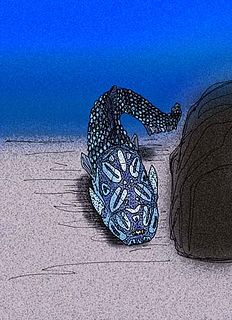
Mizia is a genus of primitive antiarch placoderm found in Emsian-aged marine strata of Early Devonian China.

Galeaspida is an extinct taxon of jawless marine and freshwater fish. The name is derived from galea, the Latin word for helmet, and refers to their massive bone shield on the head. Galeaspida lived in shallow, fresh water and marine environments during the Silurian and Devonian times in what is now Southern China, Tibet and Vietnam. Superficially, their morphology appears more similar to that of Heterostraci than Osteostraci, there being currently no evidence that the galeaspids had paired fins. However, Galeaspida are in fact regarded as being more closely related to Osteostraci, based on the closer similarity of the morphology of the braincase.
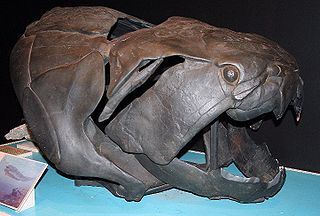
Dunkleosteidae is an extinct family of arthrodire placoderms. The gigantic apex predator Dunkleosteus terrelli is the best known member of this group. While they were previously thought to be close relatives of the genus Dinichthys and grouped together in the family Dinichthyidae, more recent studies have shown that the two taxa represent two very distinct clades within Arthrodira. The reappraisal of Kiangyousteus lead to a restructuring of the family, with the inclusions of the benthic, aberrant Heterosteus as the sister taxon of Dunkleosteus, and the Late Emsian Xiangshuiosteus as the sister taxon of Eastmanosteus calliaspis, and the removal of Westralichthys from the family.

Quasipetalichthys haikouensis is the type and only known species of the extinct petalichthid placoderm, Quasipetalichthys. Fossil remains of Quasipetalichthys have been found in the Middle Devonian, Givetian faunal stage of China.
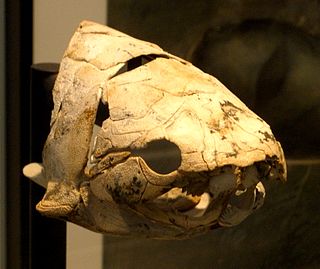
Eastmanosteus is a fossil genus of dunkleosteid placoderms. It was closely related to the giant Dunkleosteus, but differed from that genus in size, in possessing a distinctive tuberculated bone ornament, a differently shaped nuchal plate and a more zig-zagging course of the sutures of the skull roof.
Potangaspis is an extinct genus of placoderm fish which existed in China during the Devonian period. It was first named by Zhu Min, Wang Jun-qing, and Wang Shi-tao in 2010, and the type species is Potangaspis parvoculatus.

Yiminaspis shenme is a species of primitive arthrodire placoderm from Emsian-aged marine strata in Yunnan, China. It is closely related to Wuttagoonaspis of Middle Devonian Australia. Y. shenme is known from a flattened partial skull and portions of the thoracic armor.
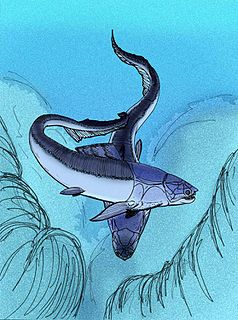
Xiangshuiosteus wui is a brachythoracid arthrodire placoderm from the Late Emsian epoch of Wuding, Yunnan. It has recently been reassessed as a dunkleosteid.

Buchanosteus is an extinct genus of arthrodire placoderm. Its fossils have been found in Early Devonian-aged marine strata throughout Asia and Australia. It contains the following species:

Neopetalichthys yenmenpaensis is an extinct petalichthid placoderm from the Early Devonian of China.

Homostiidae is a family of flattened arthrodire placoderms from the Early to Middle Devonian. Fossils appear in various strata in Europe, Russia, Morocco, Australia, Canada and Greenland.

Buchanosteidae is a family of arthrodire placoderms that lived from the Early to Middle Devonian. Fossils appear in various strata in Russia, Central Asia, Australia, and China.

Coccosteidae is a family of arthrodire placoderms from the Early to Late Devonian. Fossils appear in various strata in Europe, North America and China.

Jiuchengia longoccipita is a coccosteid arthrodire placoderm from the Late Emsian epoch of Wuding, Yunnan.
Microbrachiidae is an extinct family of tiny, advanced antiarch placoderms closely related to the bothriolepids.
Microbrachius is an extinct genus of tiny, advanced antiarch placoderms closely related to the bothriolepids. Complete articulated specimens show that the armored section of the body had an average length of 2-4 cm. Species of Microbrachius are characterized by having large heads with short thoracic armor. Specimens of Microbrachius have been found in Scotland, Belarus, Estonia, and China. Specimens range in age from the Lower Devonian Late Emsian Stage to the Middle Devonian Upper Givetian Stage.
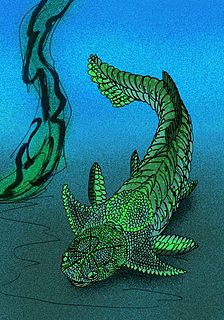
Actinolepis is an extinct genus of actinolepid placoderm from the Early Devonian. Four species are known: A. magna from Estonia, A. spinosa from Latvia, the type species A. tuberculata from New Zealand and A. zaikai from Belarus.

Heterosteus is an extinct genus of heterosteid placoderm known from remains discovered in Europe and Greenland.

Bianchengichthys is an extinct genus of "maxillate" placoderm fish from the late Silurian Period. Its fossils have been recovered from Yunnan Province, China, and it is represented by only one species: Bianchengichthys micros.

















